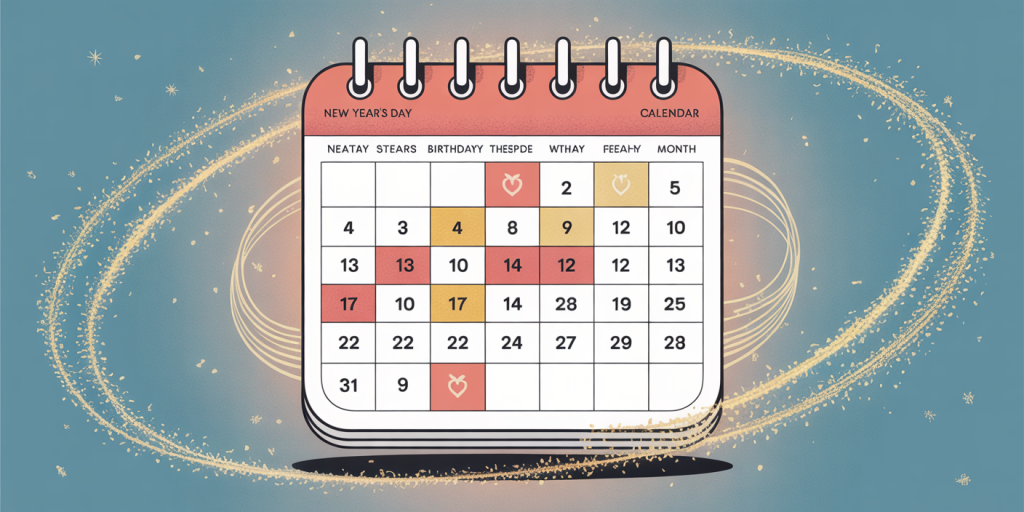Using Temporal Landmarks to Reinvent Yourself (The Fresh Start Effect)
In the complex journey of personal growth and transformation, recognizing key opportunities to reset one’s mindset and habits is crucial. Temporal landmarks are one such powerful tool, offering psychological leverage to help individuals break free from past failures and embark on a renewed self-improvement journey. Known in behavioral science as the “Fresh Start Effect,” temporal landmarks mark distinct points in time that psychologically separate the present from the past, providing a clean slate for goal-setting and lifestyle changes. This article explores how temporal landmarks function, practical ways to use them for self-reinvention, real-world case studies, and future trends in leveraging this fascinating psychological phenomenon.
Understanding Temporal Landmarks and the Fresh Start Effect
Temporal landmarks refer to specific moments in time that stand out from the routine flow of days and weeks, such as birthdays, the start of a week or month, New Year’s Day, or even personal milestones like graduation or moving to a new city. These landmarks create cognitive boundaries, making people view their lives as segmented chapters. This segmentation enables individuals to dissociate from past mistakes or inertia, thereby enhancing motivation and the commitment to new goals.

A seminal study published in the *Journal of Experimental Social Psychology* (Dai, Milkman, & Riis, 2014) demonstrated that people are more likely to engage in aspirational behavior immediately after a temporal landmark. For example, gym attendance spikes on New Year’s Day and fees paid for weight loss programs typically increase in the first week of January. This “Fresh Start Effect” induces a psychological reframe: past failures are compartmentalized as belonging to the “old self,” allowing the “new self” to pursue transformation unburdened by previous inadequacies.
How Temporal Landmarks Enhance Motivation and Behavior Change
Temporal landmarks serve as natural motivators because they create what psychologists call a “psychological reset.” This reset functions similarly to how software rebooting improves performance, allowing individuals to recalibrate their mindset. When people perceive a fresh start, their self-efficacy—the belief in their ability to succeed—receives a powerful boost. This is especially effective when tied to goal setting and tangible behaviour changes.
For example, consider the common behavior of dieting. While many attempts fail due to discouragement from prior setbacks, framing a new diet regimen around the first day of a month can increase adherence. Longitudinal data from behavioral studies show that people who align their efforts with temporal landmarks are 45% more likely to reach their goals at the 3-month mark compared to those who start on arbitrary days without symbolic significance.
Moreover, temporal landmarks reduce procrastination. By psychologically distancing present efforts from past failures, procrastinators find it easier to initiate tasks and persist over time. This happens because the fresh start diminishes the burden of self-judgment, fostering a more compassionate and constructive mindset toward goal pursuit. For instance, using the “Monday reset” as a temporal landmark can turn weekly productivity around for professionals who struggle with consistent output.
Practical Applications: Using Temporal Landmarks to Reinvent Yourself
Aligning Goal Setting with Significant Dates
One effective way to harness temporal landmarks is to deliberately set goals around meaningful dates such as birthdays, anniversaries, or culturally significant days like the lunar new year. These dates personally resonate and thus create emotional salience, increasing commitment.
For example, a 35-year-old wanting to adopt a healthier lifestyle might choose their birthday as the starting point to overhaul diet and exercise behavior. This conscious choice transforms the birthday from a day of reflection to a launching pad for change. Demonstrating this effect, a survey by Behavioral Science & Policy Association (2019) found that 60% of successful New Year’s resolution participants chose the first day of the year or personal milestones to begin their journey, compared to only 25% of unsuccessful participants.
Utilizing Weekly and Monthly Cycles
Temporal landmarks extend beyond yearly events. The start of each week or month also functions as a minor fresh start. For instance, a professional aiming to boost productivity might set Monday mornings as the dedicated planning session for the week ahead. Similarly, tracking progress month-by-month can reinforce momentum and allow recalibration before the next temporal reset.
Daily journaling apps such as Day One and productivity tools like Todoist often incorporate these principles by encouraging weekly and monthly reviews. This reinforces the natural psychological effect of temporal landmarks by institutionalizing reflection and recommitment.
Case Study: Weight Loss Journey Using Temporal Landmarks
Consider the case of Jane, who struggled for years with weight management. Traditional advice hadn’t worked until she used temporal landmarks strategically. Jane decided to identify quarterly dates based on the calendar—January 1st, April 1st, July 1st, and October 1st—as fresh starts. On each of these dates, she embarked on a 90-day diet and exercise focus, tracked via a fitness app.
Within a year, Jane lost 20% of her body weight and maintained the progress, attributing her success to the psychological empowerment of fresh starts. The periodic temporal cues helped her compartmentalize challenges, avoid burnout, and springboard her motivation repeatedly.
Comparative Table: Temporal Landmark Types and Their Effectiveness in Goal Reinvention
| Temporal Landmark Type | Typical Motivation Boost (%) | Best For | Frequency | Emotional Impact Level |
|---|---|---|---|---|
| New Year’s Day | 65% | Long-term lifestyle goals | Yearly | High |
| Birthdays | 60% | Personal renewal and habits | Yearly | High |
| Start of Week (Monday) | 40% | Productivity & habit tasks | Weekly | Moderate |
| Start of Month | 50% | Monthly progress tracking | Monthly | Moderate-High |
| Moving to New Place | 55% | Identity and social behavior | Variable | High |
| Graduation/Promotion | 45% | Career-related goals | Once, event-based | High |
The table highlights that while yearly landmarks like New Year’s Day often carry the highest motivation spike, more frequent landmarks such as weekly or monthly starts provide regular boosts that cumulatively support sustained behavior change.

Leveraging Technology and Social Support with Temporal Landmarks
In today’s digital age, integrating temporal landmarks with technology can exponentially increase their effectiveness. Apps that send notifications or reminders on meaningful landmark days can prompt reflection and goal re-commitment. For instance, fitness trackers can mark “day one” of a new month and encourage immediate engagement in health activities.
Social support networks also interplay with temporal landmarks. Group challenges or social media campaigns around fresh starts (e.g., “New Month, New You” Instagram campaigns) harness collective motivation. This social dimension amplifies accountability, which research from *Health Psychology* journal (2018) reports as increasing the likelihood of goal attainment by up to 30%.

An example can be seen in the “Dry January” campaign, where participants collectively abstain from alcohol for the first month of the year. The campaign leverages the temporal landmark of January 1st and social support, creating one of the most successful behavior change movements globally, with over 4 million participants in 2023 alone.
Challenges and Limitations of Using Temporal Landmarks
While temporal landmarks offer powerful psychological benefits, they are not a guaranteed solution for every individual or situation. Some people may over-rely on fresh starts and repeatedly postpone meaningful change, a phenomenon known as “start-itis.” This delay can erode motivation over time.
Furthermore, the emotional impact of temporal landmarks may vary across cultures. For example, Western cultures emphasize New Year’s resolutions, whereas in East Asian societies, lunar new year celebrations hold greater significance as fresh-start moments. Thus, understanding one’s cultural context is essential to effectively harness temporal landmarks.
Additionally, unplanned life events like illness or job loss can disrupt the momentum generated by temporal landmarks. Flexibility and compassionate self-forgiveness remain necessary to navigate such setbacks.
Future Perspectives: Harnessing Temporal Landmarks for Sustainable Transformation
Looking ahead, the intersection of behavioral science, technology, and personalized coaching promises exciting advances in optimizing temporal landmarks for self-reinvention. Artificial intelligence (AI)-powered apps could tailor temporal landmark interventions based on individual behavior patterns, enhancing timing and messaging to maximize motivation.
Wearable tech could integrate physiological feedback, offering dynamically timed fresh starts triggered by biometrics like sleep cycles or stress levels. Such biofeedback loops may redefine temporal landmarks not only by calendar dates but also by bodily rhythms.
Moreover, with increasing societal awareness of mental health challenges, combining temporal landmarks with mindfulness and resilience training could form a holistic approach to transformation. For example, psychologists might guide clients to create personalized “temporal maps” that identify optimal fresh start moments aligned with their emotional readiness and life context.
Scientific research will likely continue to refine which types of landmarks most effectively drive lasting change across different demographics and cultures. Longitudinal data collection and big data analytics could shed light on the nuanced relationship between temporal landmarks and successful habit formation.
In the social sphere, community and workplace initiatives that pioneer temporal landmark-focused programs could foster healthier, more motivated populations. Organizations adopting this approach may see improved employee well-being and productivity, driven by structured “fresh start” interventions throughout the year.
